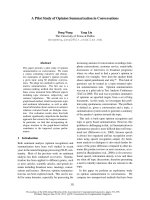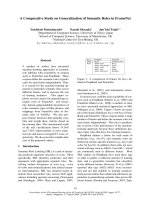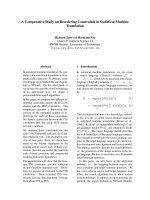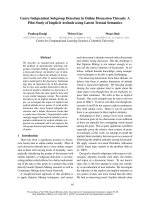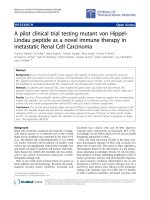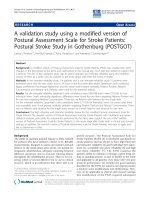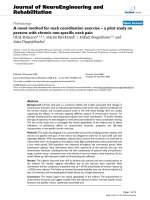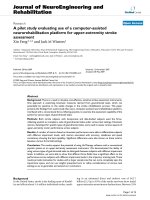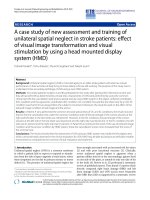Báo cáo hóa học: " A novel method for neck coordination exercise – a pilot study on persons with chronic non-specific neck pain" docx
Bạn đang xem bản rút gọn của tài liệu. Xem và tải ngay bản đầy đủ của tài liệu tại đây (312.51 KB, 10 trang )
BioMed Central
Page 1 of 10
(page number not for citation purposes)
Journal of NeuroEngineering and
Rehabilitation
Open Access
Methodology
A novel method for neck coordination exercise – a pilot study on
persons with chronic non-specific neck pain
Ulrik Röijezon*
1,2,3
, Martin Björklund
1,3
, Mikael Bergenheim
1,4
and
Mats Djupsjöbacka
1
Address:
1
Centre for Musculoskeletal Research, University of Gävle, Gävle, Sweden,
2
Department of Community Medicine and Rehabilitation,
Physiotherapy, University of Umeå, Umeå, Sweden,
3
Alfta Research Foundation, Alfta, Sweden and
4
Department of Surgery, Central Hospital
Karlstad, Karlstad, Sweden
Email: Ulrik Röijezon* - ; Martin Björklund - ;
Mikael Bergenheim - ; Mats Djupsjöbacka -
* Corresponding author
Abstract
Background: Chronic neck pain is a common problem and is often associated with changes in
sensorimotor functions, such as reduced proprioceptive acuity of the neck, altered coordination of
the cervical muscles, and increased postural sway. In line with these findings there are studies
supporting the efficacy of exercises targeting different aspects of sensorimotor function, for
example training aimed at improving proprioception and muscle coordination. To further develop
this type of exercises we have designed a novel device and method for neck coordination training.
The aim of the study was to investigate the clinical applicability of the method and to obtain
indications of preliminary effects on sensorimotor functions, symptoms and self-rated
characteristics in non-specific chronic neck pain
Methods: The study was designed as an uncontrolled clinical trial including fourteen subjects with
chronic non-specific neck pain. A new device was designed to allow for an open skills task with
adjustable difficulty. With visual feedback, subjects had to control the movement of a metal ball on
a flat surface with a rim strapped on the subjects' head. Eight training sessions were performed over
a four week period. Skill acquisition was measured throughout the intervention period. After
intervention subjects were interviewed about their experience of the exercise and pain and
sensorimotor functions, including the fast and slow components of postural sway and jerkiness-,
range-, position sense-, movement time- and velocity of cervical rotation, were measured. At six-
month follow up, self-rated pain, health and functioning was collected.
Results: The subjects improved their skill to perform the exercise and were overall positive to
the method. No residual negative side-effects due to the exercise were reported. After
intervention the fast component of postural sway (p = 0.019) and jerkiness of cervical rotation (p
= 0.032) were reduced. The follow up showed decreased disability (one out of three indices) and
fear of movement, and increased general health (three out of eight dimensions).
Conclusion: The results support the clinical applicability of the method. The improvements in
sensorimotor functions may suggest transfer from the exercise to other, non-task specific motor
functions and justifies a future randomized controlled trial.
Published: 23 December 2008
Journal of NeuroEngineering and Rehabilitation 2008, 5:36 doi:10.1186/1743-0003-5-36
Received: 9 June 2008
Accepted: 23 December 2008
This article is available from: />© 2008 Röijezon et al; licensee BioMed Central Ltd.
This is an Open Access article distributed under the terms of the Creative Commons Attribution License ( />),
which permits unrestricted use, distribution, and reproduction in any medium, provided the original work is properly cited.
Journal of NeuroEngineering and Rehabilitation 2008, 5:36 />Page 2 of 10
(page number not for citation purposes)
Background
Chronic neck pain is a common problem [1]. Since the
knowledge on the pathophysiology is scarce, treatment
efforts are largely pragmatic, focusing on pain manage-
ment and restoring functioning and abilities. In order to
advance the efficacy of treatment and rehabilitation, new
knowledge has to be integrated in clinical practice. One
area that has generated much novel results over the last
years is the research on sensorimotor functions in chronic
neck pain. Thus, a wide range of changes in sensorimotor
functions have been identified in these conditions, such
as: reduced proprioceptive sensibility of the neck [2,3]
and shoulder [4]; increased jerkiness of cervical rotations
[3]; impaired postural control in quiet stance [5-8]; and
altered activation patterns of cervical muscles [9]. Based
on such evidence from clinical research, along with data
from experimental studies, several models on the patho-
genesis of chronic musculoskeletal pain conditions
includes mechanisms involving sensorimotor functions
(e.g., [10,11]).
In line with the above, studies on neck pain patients eval-
uating the efficacy of exercise regimes targeting cervical
sensorimotor functions have shown promising results.
Thus, specific exercises for eye-head-neck coordination
were shown to reduce pain [12-14] as well as to improve
kinaesthetic sense and cervical range of movement
[12,14] at retests after interventions. To improve the neu-
romuscular coordination of the deep ventral cervical mus-
cles, a specific cranio-cervical flexion exercise has been
developed together with an adherent device. This exercise
was shown to reduce headache in patients suffering from
cervicogenic headache [15] as well as to reduce pain and
improve kinaesthetic sense in chronic neck pain patients
[14].
The above mentioned exercises focus on slow movements
and closed skills tasks (i.e., the task is highly predictable).
Drawing on the literature on motor learning, an opportu-
nity for further development of exercises targeting senso-
rimotor function of the neck resides in designing an
exercise which entails a more open skills task, for example
via an unstable dynamic system. Such an exercise is less
predictable and demand on-line adjustments of the neu-
romuscular control system. The exercise should preferably
be performed in a functional position and include active
problem solving, feedback of results as well as progression
of difficulty in order to promote motor learning [16]. To
achieve persistence of the exercise effects, as well as trans-
fer to different tasks and task contexts, it is vital to imple-
ment components of variation and cognitive effort [17].
These components are partly inherent in open skills tasks.
Lastly, to be applicable in a clinical setting, the exercise
task needs to be easy to understand for the patient, the
equipment convenient to use and the level of task diffi-
culty adjustable to suit the individual patient's skill level.
Based on these theoretical and empirical premises we
judged that the development of novel methods for neck
coordination exercises is important in order to improve
the rehabilitation of people suffering from chronic neck
pain.
The present paper describes a novel exercise method aim-
ing at improving sensorimotor functioning of the neck,
and a pilot study of its clinical applicability and prelimi-
nary indications of its efficacy for persons with chronic
non-specific neck pain. The specific aims were to study the
skill acquisition and to assess the subjects experiences of
the exercise. A further aim was to find out preliminary
information about changes in sensorimotor functions,
pain and self-reported characteristics after a four week
exercise period with the novel method.
Methods
The study was designed as an uncontrolled clinical trial.
Baseline measurements and post intervention measure-
ments were collected within a week before and a week
after the intervention, respectively. Follow up measure-
ments were collected six months after the last exercise ses-
sion. The study was approved by the Regional Ethical
Review Board in Uppsala and written informed consent
was obtained from all subjects before the start of the trial.
Subjects
Seventeen subjects were recruited from a vocational reha-
bilitation center (Alfta Rehab Center, Sweden) and by
advertising in the surrounding area. The inclusion criteria
were non-traumatic neck pain, location confirmed with
pain drawings [18], with a duration of at least three
months, age of 18–50 years and a disability score of 10 or
more on the Neck Disability Index (NDI) (scale 0–100)
[19]. Subjects were excluded if they had evidence of surgi-
cal operation or injury with fracture or luxation of the
spine or shoulder, neurological or rheumatic disease, or if
they were unable to rotate the head 25° bilaterally or bal-
ance a light flat pillow on the head for five seconds (s).
Three subjects were excluded from the analysis; two due to
misclassification of the NDI scores at the inclusion and
one for whom neck trauma was discovered during the
interview after commencing the trial. Thus the results are
based on 14 subjects (10 females), with the mean age of
35 (SD 10) years, and a median pain duration of 60
months (IQR, 26.5–118).
Treatment intervention
A newly developed device (patent SE serial # 530879) was
used for the neck-coordination exercise. The device was
designed to allow for an exercise involving an open skills
task, task variation, continuous feedback and progression
of difficulty (fig. 1). The device consisted of a plate with
Journal of NeuroEngineering and Rehabilitation 2008, 5:36 />Page 3 of 10
(page number not for citation purposes)
exchangeable surface (fig. 2) and a removable rim (fig. 3)
(weighing altogether 760 gram). Four different surfaces
was used to increase difficulty in the following order:
fleece fabric (Malden Mills Polartec
®
Classic 100), cotton
fabric, copy paper (80 g/m
2
), all glued on a Plexiglas
board, and finally an uncovered Plexiglas board.
The exercise was performed in a functional sitting posi-
tion in an adjustable office chair. The subject was pro-
vided with visual feedback of the device via mirrors. To
ensure a good sitting posture during the exercise, the sub-
ject was instructed to sit upright with lumbar support and
the head balanced in line with the torso, the hips and
knees about 90° flexion and the lower arms resting on
armrests. In this position the task was to move the metal
ball (weight 220 gram) from a starting position, by con-
Schematic of the neck coordination exercise apparatusFigure 1
Schematic of the neck coordination exercise appara-
tus. The exercise task was to control the movement of a
metal ball on a flat surface mounted on the subjects head.
Mirrors
Metal ball
Rim
Surface
Exploded drawing of the neck coordination exercise device, including the removable rim and an exchangeable surfaceFigure 2
Exploded drawing of the neck coordination exercise
device, including the removable rim and an
exchangeable surface. Four different surfaces were used
in order to vary the rolling resistance of the ball.
Rim
Surface
The removable rim viewed from the side and from aboveFigure 3
The removable rim viewed from the side and from
above. Before commencing a trial, the subject should place
the ball in a starting position (at front, back, left or right) by
tilting the plate. All measurements are in millimetres.
Rim
25
Starting
positions
45
320
110
Journal of NeuroEngineering and Rehabilitation 2008, 5:36 />Page 4 of 10
(page number not for citation purposes)
trolled movements of the head, to the centre of the plate
and hold it still for three s (see additional file 1: Movie 1
for the neck coordination exercise.mpg). The three second
period was chosen to require that the subjects could fine
control the positioning of the ball. The location of the ball
at starting and target positions was monitored by LED-
photocell detectors. The signals from these detectors were
monitored by a PC and allowed for automation of the
training, including delivery of pre-recorded verbal instruc-
tions. The trunk was fixed to the chair via a strap placed
around the subjects torso as seen in Figure 1., in order to
promote movements with the neck and head rather than
with the trunk. After succeeding with the task, or after 47
s if the task was not successfully completed, the subject
was instructed to move the ball to another starting posi-
tion. Light emitting diodes indicated the starting position
and when the ball was at the center of the plate. When the
subject had acquired the skill to complete at least five tri-
als in a block of six trials, with each trial completed within
30 s, the difficulty of the task was increased by changing
the surface to a faster one (i.e., lower rolling resistance).
The intervention consisted of eight training sessions per-
formed two-three times per week over a time period of
four weeks. Each session lasted 10–15 minutes and con-
sisted of three blocks of six trials. The exercise dose and
the progression of difficulty were based on a previous
pilot study on eight healthy adults (six males), with a
mean age of 26. The healthy group performed eight exer-
cise sessions over a four week period. Improvement in
exercise performance was measured and the subjects
where interviewed after the exercise period. No other
measurements where collected. All the healthy subjects
showed a rapid improvement in the exercise performance.
The interviews revealed an overall positive opinion about
the exercise method and no adverse effects were reported
other than transient discomfort and tiredness. The most
common strategies to succeed with the task were to per-
form small and slow movements. The supervision of the
exercise and the collecting of measurements in the previ-
ous and the present pilot studies were executed in a clini-
cal setting by the first author.
Outcome measures
Measurements collected at baseline were sensorimotor
function tests, questionnaires and pain measurements.
Post intervention measurements were sensorimotor func-
tion tests, pain measurements and subjective experience
of the exercise. Six months follow up was accomplished
with questionnaires and pain ratings. Throughout the
exercise period skill acquisition was measured.
Clinical applicability
The acquisition of the skill to perform the neck coordina-
tion task was assessed by recording the trial times as well
as monitoring the rate of progression to successively faster
surfaces during the intervention period. The outcome var-
iable for the improvement in performing the task, was the
slope of the linear regression of the trial times on the fast-
est surface for each subject. Such calculations were not
performed for the slower surfaces due to rapid progres-
sion, resulting in insufficient data (i.e., to few blocks of tri-
als) for a meaningful regression analysis.
To assess the subjective experiences of the method, the
subjects were interviewed after the last training session by
the test leader asking predetermined questions. Questions
included in the interview were: (1) What is your overall
opinion about the training method? (2) How comfortable
was the plate on the head? (3) Were the instructions easy
to understand? (4) Did you experience tiredness, discom-
fort or pain from the training? (5) Did you use any strat-
egy when trying to succeed with the exercise task? For each
question a few categories were formed on the basis of the
replies.
Sensorimotor function tests
Tests of postural sway and cervical axial rotation were per-
formed in quiet stance bare footed on a force platform
with the feet together, heel-to-heel and toe-to-toe. Instruc-
tions were pre-recorded and provided through speakers.
The test order was the same for all subjects, starting with
postural sway followed by cervical rotation. The selection
of tests and the sensorimotor variables calculated from
these tests were based on two premises: (1) that they have
discriminative value for people with chronic neck pain
[2,3,5-8] and (2) that they represent different aspects of
sensorimotor control as indicated by weak or absent inter-
variable correlations [20,21].
In the postural sway test the subject was instructed to
stand as still as possible during 30 s with eyes closed and
arms crossed over the chest. Prior to the test a 10-s training
session was given. A static force platform (Kistler Force
Measurements, type 9807, Kistler Instrumente AG, Swit-
zerland) was used for measuring the centre of pressure
(CoP) migration in the anterior-posterior and medio-lat-
eral directions with a sampling frequency of 30 Hz. It is
well established that the CoP signal is composed of two
main components, one slow and one fast, reflecting sepa-
rate mechanisms of the postural control system (e.g.,
[22,23]). We chose to decompose the CoP signals into the
slow rambling (Ra) and fast trembling components (Tr)
according to the method described by Zatsiorsky and
Duarte [22]. As outcome variables we calculated the 95%
confidence area of the ellipse of the Ra and Tr trajectories
from 24 s of the data, excluding 5 s at the beginning and
1 s at the end of the trial.
Journal of NeuroEngineering and Rehabilitation 2008, 5:36 />Page 5 of 10
(page number not for citation purposes)
The cervical rotation test was performed in two separate
conditions in randomized order; rotation to the right and
to the left. In each condition, a block of eight consecutive
rotations (trials) was executed with a short resting interval
between trials. The subject was instructed to rotate the
head with a fast movement as far as possible. Prior to each
trial the subject was instructed to memorize the starting
position, which was a self-selected neutral position of the
head, and to reproduce this position as accurately as pos-
sible after each head rotation. The instruction given was
"memorize your head position", "make a fast rotation of
your head as far as possible" and "return to the starting
position as accurately as possible". Prior to each block the
subject was given a training session of two trials. Cervical
kinematics was measured with an electromagnetic track-
ing system (FASTRAK™, Polhemus Inc, USA), with a sam-
pling rate of 60 Hz. Two receivers, one positioned on the
forehead and the other above the dorsal spinal process of
Th2, were used for recording the axial head rotation rela-
tive to the trunk. A quintic spline (generalized cross-vali-
dation spline) [24] was used for low-pass filtering and
differentiation of the angular data.
In total, five outcome variables were calculated from the
cervical rotation test: The range of movement (ROM) was
calculated as the maximal angular excursion from the
starting (normal) head position. To assess the movement
smoothness and speed, the movement time, peak velocity
and jerk index were calculated for the rotation from the
starting position to maximal excursion angle. The start
and stop of the rotation used for these calculations were
defined by a threshold of 5% of the peak angular velocity.
To estimate the acuity of cervical repositioning we calcu-
lated the variable error (VE) of repositioning. First, the dif-
ference between the reproduced angle (the angle when the
angular velocity had remained below 5% of peak velocity
for 0.5 s) and the starting angle (0.5 s before the start of
the movement) were calculated for each trial (algebraic
errors). In order to remove any systematic drift in the
errors, which is unrelated to the response variability but
will affect VE [25], the algebraic errors were detrended by
computing the residuals from a straight-line fit of the
errors. Thereafter VE was calculated as the population
standard deviation of the error residuals. The jerk index
was calculated from the third derivative of the head- trunk
angle using the algorithms described in Kitazawa et al.
[26], which normalizes the jerk cost with respect to move-
ment distance and time. For all calculations, the trials for
left and right rotations were pooled after removal of out-
lier trials (± 2 SD), and mean values were calculated,
except for ROM where the maximal value was used.
Test-retest data from other studies which included the
same methods as used in the present study was analysed
to get an indication of the reliability of the tests (intra
class correlation coefficient (ICC)) and to reveal possible
retest effects on mean values (paired t-test). The p-values
of the t-test and ICC
3,1
were for postural sway variables Ra
area p = 0.34 and ICC = 0.51 and for Tr area p = 0.81 and
ICC = 0.47 (n = 70 mixed group including healthy adults
and subjects with chronic neck pain, one week test inter-
val), and for the cervical rotation variables: jerk index p =
0.98 and ICC = 0.93, movement time p = 0.37 and ICC =
0.93, peak velocity p = 0.99 and ICC = 0.91, ROM p = 0.039
and ICC = 0.92, repositioning VE p = 0.85 and ICC = 0.73
respectively (n = 12 healthy adults, four weeks test inter-
val).
Pain and self-reported characteristics
Self-rated pain was assessed as pain at the moment and
measured within a week before the day of testing on a
blank 100 mm visual analogue scale (VAS), on which 0 mm
corresponds to "no pain at all" and 100 mm to "worst
imaginable pain" [27].
Self-reported characteristics were assessed by the follow-
ing questionnaires: The Short Form 36 (SF-36) was used as
a measure of subjective functional health and well being
[28]. Severity of symptoms and disability was measured
using the Neck Disability Index (NDI) [19]. The TAMPA
Scale of Kinesiophobia (TSK) was used to measure fear of
movement and re-injury due to movement [29]. The Self-
Efficacy Scale (SES) was used to measure confidence in per-
forming activities of daily living[30]. The Disability of the
Arm, Shoulder and Hand (DASH) questionnaire was used
to measure upper extremity disability and symptoms [31].
The indices of the questionnaires were normalized, i.e.,
expressed as percentage of the maximum score. Note that
higher scores denotes more disability in NDI and DASH
and greater fear of movement in TSK, whereas higher
scores denotes better functional health and well being in
SF-36 and higher confidence in own capability in SES.
Statistics
One sample t-test was used to analyse the slopes of the lin-
ear regression of the skill acquisition of performing the
exercise task. The presumed independence between the
sensorimotor variables was tested by calculating Pearson's
correlation coefficient between all variables. For inde-
pendent (non-correlated) variables, paired t-test were
used to assess changes between the pre- and post-interven-
tion measurements. For correlated variables repeated
measures MANOVA were used, if this MANOVA was sig-
nificant, paired t-tests were performed to identify the var-
iables that contributed to the effect. Jerk index-,
movement time-, and VE of cervical rotation were log
transformed before analysis due to skewed distribution.
The VAS measurements were analyzed with the Friedman
test and the questionnaires scores with Wilcoxon signed
ranks test. All analyses were performed using SPSS 13.0
Journal of NeuroEngineering and Rehabilitation 2008, 5:36 />Page 6 of 10
(page number not for citation purposes)
for Windows (SPSS Inc., Chicago, Illinois, USA). In all sta-
tistical tests, p < 0.05 was considered significant.
Results
Clinical applicability
All subjects improved their skill to perform the exercise
task. This was evident from the fact that all subjects pro-
gressed to the most difficult condition during the inter-
vention period and by the fact that all subjects
successively decreased their median time per block (mean
slope = -1,4 s/block, one-sample t-test; p < 0.001) on the
fastest surface (fig. 4).
Thirteen subjects were interviewed for their experience of
the exercise method. One subject was not interviewed due
to an oversight by the test leader. The interviews revealed
that none of the subjects were negative to the neck coordi-
nation exercise. Eleven subjects were positive, while two
were neutral. One subject reported discomfort from wear-
ing the device on the head. The comprehension of the
instructions was conceived as easy by all the subjects.
Seven subjects experienced tiredness, two reported dis-
comfort and four reported pain from the training. Three
subjects did not state any symptoms at all connected to
the training. A general feature for those who experienced
tiredness, discomfort or pain was that the symptoms were
transient and mainly present at the first few trainings ses-
sions. However, one subject did experience temporary
pain during training throughout the training period. This
was the same person who reported discomfort from wear-
ing the device on the head (se above). Five subjects
reported post-exercise soreness after the first two-three
training sessions. Finally, on the open question about
strategies used for the exercise task eight subjects men-
tioned deep concentration on the task, six subjects to take it
easy and to perform very small movements of the head, and
four subjects to relax.
Sensorimotor function tests
The correlation analyses of the sensorimotor variables
revealed that repositioning VE and ROM from the cervical
rotation test and Ra and Tr area from the postural sway test
Performance of the exercise task for the fastest surface during the exercise periodFigure 4
Performance of the exercise task for the fastest surface during the exercise period. The figure illustrates the distri-
bution of median trial times over all subjects separately for each block of trials. Due to variation in progression between sub-
jects the number of blocks of trials performed in this condition ranged from 11 to 20. Therefore, for block 1–11 n = 14 and for
block 12–20 n = 13, 11, 11, 10, 9, 8, 6, 3 and 1 respectively. For each box plot, the whiskers represent maximum and minimum
values, the top and bottom of the box represent the 75th and 25th quartiles and the horizontal line in the box represent the
median.
0
5
10
15
20
25
30
35
40
45
50
1234567891011121314151617181920
Time (seconds)
Block of Trials
Journal of NeuroEngineering and Rehabilitation 2008, 5:36 />Page 7 of 10
(page number not for citation purposes)
were each uncorrelated to any of the other variables,
therefore t-tests were used to assess pre-post intervention
changes. Significant decrease was seen for Tr area (p =
0.019) (Table 1). The remaining three variables, jerk index,
movement time and peak velocity from the cervical rotation
test, were significantly correlated (p < 0.01). These varia-
bles were therefore analysed with repeated measure
MANOVA, which revealed a significant change (p =
0,045). Since the MANOVA was significant, the depend-
ent variables were analysed with paired t-tests. This analy-
sis indicated that mainly decreased jerk index contributed
to the effect (p = 0.032, p = 0.320, p = 0.573 for jerk index,
movement time and peak velocity respectively).
Pain and self-reported characteristics
There was no significant decrease in VAS scores after the
four-week training period, or at six-months follow up
(median and IQR before: 49, 21–75; after: 18, 8–30; fol-
low up: 28, 21–58, p = 0.183. n = 11).
For the SF-36 significant improvement was seen in three
out of eight dimensions (Table 2). These were physical
functioning, vitality and social functioning. Functional
improvement was revealed as decreased disability meas-
ured with DASH. Also, fear of movement, measured with
TSK, decreased significantly (Table 2).
Discussion
The results expose positive findings regarding the clinical
applicability of the novel neck coordination exercise.
Also, indication on possible positive effects were seen in
some of the sensorimotor functions and self-rated charac-
teristics.
The exercise regime appeared easy to learn, as all subjects
improved their skill to perform the exercise task. This was
evident by the progression to the most difficult condition
and a successively reduced trial time on each condition
during the intervention period. These results confirm that
the design of the task and the progression of difficulty
were well adapted. Most of the subjects expressed a posi-
tive opinion about the exercise, and all subjects reported
that the task was easy to understand. The adverse effects
due to the exercise that were reported were transient tired-
ness, discomfort, pain and post-exercise soreness. These
side-effects were common and occurred predominantly in
the early phase of the intervention period, which can be
considered normal reactions due to unaccustomed exer-
cise. Only one person experienced discomfort from wear-
ing the device on the head. Together, these facts support
the applicability of the method in a clinical practice, as a
conjunction to other interventions, e.g., posture correc-
tion, manual therapy, strength and endurance exercises,
home exercises etc. Also, a majority of the subjects (8 of
13) mentioned deep concentration on the task when inter-
viewed about exercise strategies. This indicates that the
exercise involved substantial cognitive effort, which is
argued to be an important factor for retention and transfer
of motor skills [17].
Improvements in sensorimotor functions were indicated
by the significant decrease in Tr area (the fast component)
of postural sway and jerk index (see also below) of cervical
rotation. This suggests that there may be a transfer effect
from the exercise task to other, non-task specific, motor
functions, such as increased postural stability and
smoothness of cervical movements. Alternatively, these
findings may be simple retest effects. However, as pre-
sented in the Methods section, former test-retest data on
the same variables revealed no retest effects, which speaks
against such an interpretation. In accordance with the
present finding, improvements in postural sway has been
reported in studies on people with neck pain who received
physical therapy which included exercises for cervical
muscles [6,32]. A possible explanation to the effects may
be improved function of the deep cervical muscles, which
are known to contain a high density of muscle spindles,
and thereby are important for the postural control. The
importance of the proprioceptive input from the neck on
the control of posture has been revealed for example in
experiments using neck muscle vibration [33]. Moreover,
immobilisation of the cervical spine has been associated
with unbeneficial effects on sensorimotor functions. Neg-
ative effects on eye movements and postural control was
Table 1: Pre- and post intervention data from sensorimotor function tests (n = 14)
Before intervention
Mean (SD)
After intervention
Mean (SD)
p-value
Postural sway
Ra area (cm
2
) 4.27 ± 1.44 3.59 ± 1.79 0.387
Tr area (cm
2
) 1.61 ± 0.67 1.14 ± 0.75 0.019*
Cervical Rotation
ROM for left + right rotation (degrees) 142 ± 18.3 140 ± 16.7 0.480
VE for cervical repositioning (degrees) 2.54 ± 0.73 3.03 ± 1.41 0.208
Ra: rambling, Tr: trembling, ROM: range of movement, VE: variable error
*p < 0.05.
Journal of NeuroEngineering and Rehabilitation 2008, 5:36 />Page 8 of 10
(page number not for citation purposes)
reported after a one-week constant use of a cervical collar
in a group of healthy people [34]. Since the activity of the
deep cervical muscles was not assessed in the present
study the possibility of improved proprioceptive input
from these muscles remains speculative. The significant
repeated measure MANOVA for jerk index, movement time
and peak velocity from the cervical rotation test is some-
what ambiguous to interpret since it is the result of three
correlated variables. However, the subsequent paired t-
tests indicated that jerk index was the main contributor to
the effect. Reduced jerkiness after the exercise indicates
that the subjects executed the cervical rotation with
smoother movements. Less jerkiness is argued to reflect
better movement control [35]. The clinical relevance of
the effects on postural sway and smoothness of cervical
rotations is supported by studies showing increased pos-
tural sway during quiet stance in neck pain patients
[5,7,8] and recent studies showing increased jerk index [3]
and irregularities (rate of zero-crossings) [36] during cer-
vical movements in people with chronic neck pain. In
contrast to other studies on proprioceptive and coordina-
tion training [12,14] no effect was seen in cervical reposi-
tioning in the present study. The explanation may be that
cervical position sense was not influenced by this exercise,
while another possible explanation may reside in the dif-
ference in methods used for measuring position sense. In
the present study position sense was measured with sub-
jects standing, making fast movements as far as possible
while in the studies mentioned above the subjects were
seated, performing slow movements. Taken together,
these results support the use of measurements of postural
sway and cervical kinematics as outcome variables in
future randomized control trials.
A relevant question is whether the present sample has
impaired sensorimotor functions compared to healthy
controls. Comparing the present sample with a group of
healthy controls (n = 21) from an unpublished cross-sec-
tional study did not reveal significant reductions in pos-
tural control or cervical movement smoothness.
Nevertheless, as mentioned above, disturbances in these
sensorimotor functions has been documented in previous
studies on people with neck pain. Future studies on this
novel neck coordination exercise method should there-
fore preferably include specifically selected samples of
people with postural control and movement smoothness
disturbances.
The improvements seen in some of the questionnaire
scores at the six-months follow up could be either an
effect of the intervention or an effect of natural recovery
over time. The improvements of the TSK score may indi-
cate that individually adjusted exercise have positive effect
on fear of re-injury due to movement. This reasoning is
supported by the results presented by Bunketorp et al.
[37], showing that supervised individually adjusted phys-
ical exercise improved the TSK score in subjects suffering
from whiplash associated disorders.
No significant improvements were found for pain ratings
(VAS). The reason may be that this exercise has no effect
on pain, or that the dosage of the exercise was too small.
Earlier studies which have reported decreased pain ratings
after intervention involved more frequent training
regimes [12,14,15], suggesting that future studies on this
method should involve a more extensive intervention
period.
This study is limited to investigation of the clinical appli-
cability of the novel exercise for subjects with chronic
non-traumatic neck pain in a working age population.
Other possible applications that may need further explo-
ration is for rehabilitation of acute neck pain, whiplash
associated disorders and diseases that involve dysfunction
of the postural control, e.g. vestibular and neurological
diseases, as well as fall risk in elderly people. The study has
some important limitations concerning the implication of
the post intervention measurements. Firstly, the lack of a
control group and the relatively small sample size imply
that no firm conclusions can be drawn regarding the
effects on sensorimotor function tests, questionnaires and
Table 2: Questionnaire scores before intervention and at six-
months follow up (n = 12)
Before intervention
Median (IQR)
Follow up
Median (IQR)
p-value
NDI 22.0 (16.0–31.5) 15.8, (12.0–33.0) 0.061
SES 94.0, (85,1–96.5) 96.3, (87.8–99.4) 0.415
DASH 31.4, (17.2–40.7) 19.6, (10.3–28.4) 0.038*
TSK 13.8, (11,5–20.2) 7.1, (3.7–15.0) 0.013*
SF-36
pf 90.0, (75.0–91.3) 90.0, (81.3–95.0) 0.026*
rp 75.0, (37.5–100) 100, (31.3–100) 0.143
bp 51.0, (38,8–64.5) 62.0, (36.8–69.5) 0.310
gh 59.5, (44.3–73.3) 77.0, (56.3–90.8) 0.091
vt 45.0, (30.0–61.25) 67.5, (46.3–80.0) 0.006**
sf 68.8, (46.9–87.5) 100, (75.0–100) 0.007**
re 100, (25.0–100) 100, (75.0–100) 0.496
mh 76.0, (62.0–89.0) 82.0, (80.0–91.0) 0.066
pcs 47.6, (38.0–50.4) 48.8, (37.5–52.3) 0.209
mcs 44.6, (32.8–51.0) 52.8, (48.2–55.8) 0.050
Neck Disability Index (NDI), the Self-Efficacy Scale (SES), the
Disability of the Arm, Shoulder and Hand (DASH), the TAMPA Scale
of Kinesiophobia (TSK) and the Short Form 36 (SF-36) with its eight
dimensions: physical functioning (pf), role limitations due to physical
problems (rp), bodily pain (bp), general health perceptions (gh),
vitality (vt), social functioning (sf), role limitations due to emotional
problems (re) and mental health (mh). Physical component summary
(pcs) and mental component summary (mcs) represents the summary
measures of SF-36.
*p < 0.05, ** p < 0.01.
Journal of NeuroEngineering and Rehabilitation 2008, 5:36 />Page 9 of 10
(page number not for citation purposes)
pain measurements. Secondly, the tests, exercise instruc-
tions and interviews were performed by the same experi-
menter. Blinded test leaders are needed in future studies.
Thirdly, eight training sessions of 10–15 minutes is a rel-
atively small dosage, which implies that the exercise may
not have reached full effect. Lastly, the sensitivity of the
sensorimotor function tests can likely be improved.
Longer sampling periods for the postural sway test would
probably improve the reliability of the slow component
specifically. Testing the postural sway in different condi-
tions could also be valuable, e.g., with open and closed
eyes, on firm and soft surface and by using perturbation,
such as vibration of calf and neck muscles and galvanic
stimulation of the vestibular nerves. The cervical reposi-
tioning test may be more sensitive if performed with slow
movements in a sitting position.
Conclusion
All subjects improved their skill to perform the exercise
task. The comprehension of the task was conceived as
easy, and a majority expressed a positive opinion about
the exercise. Although transient pain and discomfort was
common, especially in the early phase of the exercise
period, no residual negative side-effects were reported.
Taken together, this supports the clinical applicability of
the method. The indications on improvements in sensori-
motor functions may suggest transfer from the exercise
task to other, non-task specific motor functions. The
results support a future randomized controlled trial on
the exercise effects.
Competing interests
The study was supported by funding from Alfta Research
Foundation. The patent for the novel device is owned by
three of the authors and mr Larson, the engineer.
Authors' contributions
UR participated in the design of the study, carried out the
data acquisition, and the statistical analyses and drafted
the manuscript. MBJ participated in the design and coor-
dination of the study, the statistical analyses and helped
to draft the manuscript. MBE participated in the design
and coordination of the study. MD conceived of the study,
participated in the design, statistical analyses of the study
and helped to draft the manuscript. All authors read and
approved the final manuscript.
Additional material
Acknowledgements
The authors would like to thank Nisse Larson for excellent engineering
assistance, Maria Frykman for valuable assistance during data collection and
Margaretha Marklund for graphical work.
References
1. Guez M, Hildingsson C, Nilsson M, Toolanen G: The prevalence of
neck pain: a population-based study from northern Sweden.
Acta Orthop Scand 2002, 73:455-459.
2. Kristjansson E, Dall'Alba P, Jull G: A study of five cervicocephalic
relocation tests in three different subject groups. Clin Rehabil
2003, 17:768-774.
3. Sjölander P, Michaelson P, Jaric S, Djupsjöbacka M: Sensorimotor
disturbances in chronic neck pain – range of motion, peak
velocity, smoothness of movement, and repositioning acuity.
Man Ther 2008, 13:122-131.
4. Sandlund J, Djupsjöbacka M, Ryhed B, Hamberg J, Björklund M: Pre-
dictive and discriminative value of shoulder proprioception
tests for patients with whiplash-associated disorders. J Rehabil
Med 2006, 38:44-49.
5. McPartland JM, Brodeur RR, Hallgren RC: Chronic neck pain,
standing balance, and suboccipital muscle atrophy – a pilot
study. J Manipulative Physiol Ther 1997, 20:24-29.
6. Karlberg M, Magnusson M, Malmstrom EM, Melander A, Moritz U:
Postural and symptomatic improvement after physiother-
apy in patients with dizziness of suspected cervical origin.
Arch Phys Med Rehabil 1996, 77:874-882.
7. Michaelson P, Michaelson M, Jaric S, Latash ML, Sjolander P, Djupsjo-
backa M: Vertical posture and head stability in patients with
chronic neck pain. J Rehabil Med 2003, 35:229-235.
8. Field S, Treleaven J, Jull G: Standing balance: a comparison
between idiopathic and whiplash-induced neck pain. Man
Ther 2008, 13:183-191.
9. Falla D, Jull G, Hodges PW: Feedforward activity of the cervical
flexor muscles during voluntary arm movements is delayed
in chronic neck pain. Exp Brain Res 2004, 157:43-48.
10. O'Leary S, Falla D, Jull G: Recent advances in therapeutic exer-
cise for the neck: implications for patients with head and
neck pain. Aust Endod J 2003, 29:138-142.
11. Johansson H, Arendt-Nilsson L, Bergenheim M, Blair S, van Dieen J,
Djupsjöbacka M, Fallentin N, Gold JE, Hägg G, Kalezic N, et al.: Epi-
logue:An integrated model for chronic work-related myalgia
"Brussels Model". In Chronic work-related myalgia Neuromuscular
mechanisms behind work-related chronic muscle pain syndromes Edited
by: Johansson H, Windhorst U, Djupsjöbacka M, Passatore M. Gävle
University Press; 2003:291-300.
12. Revel M, Minguet M, Gregoy P, Vaillant J, Manuel JL: Changes in cer-
vicocephalic kinesthesia after a proprioceptive rehabilitation
program in patients with neck pain: a randomized controlled
study. Arch Phys Med Rehabil 1994, 75:895-899.
13. Fitz-Ritson D: Phasic Exercises for Cervical Rehabilitation
After "Whiplash" Trauma. J Manipulative Physiol Ther 1995,
18:21-24.
14. Jull G, Falla D, Treleaven J, Hodges P, Vicenzino B: Retraining cer-
vical joint position sense: The effect of two exercise regimes.
J Orthop Res 2007, 25:404-412.
15. Jull G, Trott P, Potter H, Zito G, Niere K, Shirley D, Emberson J,
Marschner I, Richardson C: A randomized controlled trial of
Additional file 1
Neck coordination exercise. Movie of neck coordination exercise per-
formed with the novel device on a medium fast surface.
Click here for file
[ />0003-5-36-S1.mpg]
Publish with BioMed Central and every
scientist can read your work free of charge
"BioMed Central will be the most significant development for
disseminating the results of biomedical research in our lifetime."
Sir Paul Nurse, Cancer Research UK
Your research papers will be:
available free of charge to the entire biomedical community
peer reviewed and published immediately upon acceptance
cited in PubMed and archived on PubMed Central
yours — you keep the copyright
Submit your manuscript here:
/>BioMedcentral
Journal of NeuroEngineering and Rehabilitation 2008, 5:36 />Page 10 of 10
(page number not for citation purposes)
exercise and manipulative therapy for cervicogenic head-
ache. Spine 2002, 27:1835-1843. discussion 1843.
16. Guadagnoli MA, Lee TD: Challenge point: a framework for con-
ceptualizing the effects of various practice conditions in
motor learning. J Mot Behav 2004, 36:212-224.
17. Lee T, Swinnen S, Serrien D: Cognitive effort and motor learn-
ing. Quest 1994, 46:324-328.
18. Margolis RB, Tait RC, Krause SJ: A rating system for use with
patient pain drawings. Pain 1986, 24:57-65.
19. Vernon H, Mior S: The Neck Disability Index: a study of relia-
bility and validity. J Manipulative Physiol Ther 1991, 14:409-415.
20. Treleaven J, Jull G, Lowchoy N: The relationship of cervical joint
position error to balance and eye movement disturbances in
persistent whiplash. Man Ther 2005, 11(2):99-106.
21. Michaelson P: Sensorimotor characteristics in chronic neck
pain. Possible pathophysiological mechanisms and implica-
tions for rehabilitation. In PhD thesis Umeå University. New Series
928. ISSN 0346-6612 ISBN 91-7305-744-4, Faculty of Medicine, Sur-
gical and Perioperative Sciences; 2004.
22. Zatsiorsky VM, Duarte M: Instant equilibrium point and its
migration in standing tasks: rambling and trembling compo-
nents of the stabilogram. Motor Control 1999, 3:28-38.
23. Kiemel T, Oie KS, Jeka JJ: Slow dynamics of postural sway are in
the feedback loop. J Neurophysiol 2006, 95:1410-1418.
24. Woltring HJ: A fortran package for generalized, cross-valida-
tory spline smoothing and differentiation. Advances in Engineer-
ing Software and Workstations 1986, 8:104-113.
25. van Beers RJ, Sittig AC, Denier van der Gon JJ: How humans com-
bine simutaneous proprioceptive and visual position infor-
mation. Experimental Brain Research 1996, 111:253-261.
26. Kitazawa S, Goto T, Urushihara Y: Quantitative evaluation of
reaching movements in cats with and without cerebellar
lesions using normalized integral of jerk. Edited by: Mano N,
Hamada I, DeLong MR. Amsterdam ; New York: Excerpta Medica;
1993:11-19.
27. Huskisson EC: Measurement of pain. Lancet 1974, 2:1127-1131.
28. Ware JES, K K, Kosinski M, Gandek B: SF-36 Health Survey: Man-
ual and interpretation guide. Boston: The Health Institute; 1993.
29. Kori S, Miller R, Todd D: Kinesophobia: a new view of chronic
pain behaviour. Pain Manage 1990:35-43.
30. Altmaier EM, Russell DW, Feng Kao C, Lehmann TR, Weinstein JN:
Role of self-efficacy in rehabilitation outcome among chronic
low back pain patients. Journal of Counseling Psychology 1993,
40:335-339.
31. Hudak PL, Amadio PC, Bombardier C: Development of an upper
extremity outcome measure: the DASH (disabilities of the
arm, shoulder and hand) [corrected]. The Upper Extremity
Collaborative Group (UECG). Am J Ind Med 1996, 29:602-608.
32. Stapley PJ, Beretta MV, Toffola ED, Schieppati M: Neck muscle
fatigue and postural control in patients with whiplash injury.
Clinical Neurophysiology 2006, 117:610-622.
33. Kavounoudias A, Gilhodes JC, Roll R, Roll JP: From balance regu-
lation to body orientation: two goals for muscle propriocep-
tive information processing? Experimental Brain Research 1999,
124(1):80-88.
34. Karlberg M, Magnusson M, Johansson R: Effects of restrained cer-
vical mobility on voluntary eye movements and postural
control. Acta Otolaryngol 1991, 111:664-670.
35. Yan JH, Thomas JR, Stelmach GE, Thomas KT: Developmental fea-
tures of rapid aiming arm movements across the lifespan. J
Mot Behav 2000, 32:121-140.
36. Grip H, Sundelin G, Gerdle B, Stefan Karlsson J: Cervical helical
axis characteristics and its center of rotation during active
head and upper arm movements-comparisons of whiplash-
associated disorders, non-specific neck pain and asympto-
matic individuals. J Biomech 2008, 41:2799-2805.
37. Bunketorp L, Lindh M, Carlsson J, Stener-Victorin E: The effective-
ness of a supervised physical training model tailored to the
individual needs of patients with whiplash-associated disor-
ders – a randomized controlled trial.
Clin Rehabil 2006,
20:201-217.
